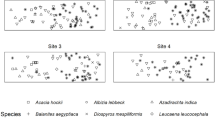Abstract
Calculating aggregation index by the sample-plot data used to lead to computing error due to the existence of a boundary effect. Here, we suggest a method for adjusting boundary effect in the analysis of spatial patterns at different stages of development of the broad-leaved Korean pine forest. This method is good for the reasonable management and biological control of the forests. The total station was used to sample the relative coordinates data at four corners of the temporary sample plot and of each tree in the field. Based on the sampling data, a correct approach to the boundary effect on aggregation index was put forward to the spatial pattern analysis of the broad-leaved Korean pine forest in its different stages of development. The results showed that the forest trees grew in a clumped pattern in the stage dominated by the pioneer trees, and that the trees were distributed in a random pattern in the stage dominated by the companion trees or in the mature stage. The spatial pattern of the broad-leaved Korean pine forest changing from clumped to random distribution is influenced by biological characteristic, the adaptive strategy of tree species and the natural disturbance in its entire development.
Similar content being viewed by others
References
Chen X. Y., Zhang Q. F., Wu H. Q., Song Y. C., A study on the structure and spatial patterns of Cyclobalanopsis glauca populations in western Huangshan, Acta Ecol. Sin., 1996, 16(3): 325–327 [陈小勇, 张庆费, 吴化前, 宋永昌, 黄山西坡青冈种群结构与分布格局研究, 生态学报, 1996, 16(3): 325–327]
Guan Y. X., Zhang S. G., Plot method and its application in stand spatial distribution patterns, J. Beijing For. Univ., 1992, 14(2): 1–6 [关毓秀, 张守攻, 取样方法及其在林分空间格局研究中的应用, 北京林业大学学报, 1992, 14(2): 1–6]
Hu Y. B., Hui G. Y., Qi J. Z., An H. J., Hao G. M., Analysis of spatial structure of natural Korean pine broad-leaved forest, For. Res., 2003, 16(5): 523–530 [胡艳波, 惠刚盈,戚继忠, 安慧君, 郝广明, 吉林蛟河天然阔叶红松林的空间结构分析, 林业科学研究, 2003, 16(5): 523–530]
Jin Z. X., A study of population structure and distribution pattern of Heptacodium miconioides in the Tiantai Mountain, Zhejiang, Chin. J. Ecol., 1997, 16(4): 15–19 [金则新, 浙江天台山七子花种群结构与分布格局研究, 生态学杂志, 1997, 16(4): 15–19]
Xie Z. Q., Chen W. L., Liu Z. Y., Jiang M. X., Huang H. D., Spatial distribution pattern of Cathaya argyrophylla population, Acta Bot. Sin., 1999, 41(1): 95–101 [谢宗强, 陈伟烈, 刘正宇, 江明喜, 黄汉东, 银杉种群的空间分布格局, 植物学报, 1999, 41(1): 95–101]
Xu W. D., Lin C. Q., Studies on Sampling Methods of the Mixed Forest of Korean Pines and Broadleaf Trees in Changbai Mountain, Beijing: China Forestry Publishing House, 1983: 296–302 [徐文铎, 林长清, 白山红松阔叶混交林取样方法的研究, 北京: 中国林业出版社, 1983: 296–302]
Zhang Z. G., Wang R. Q., Study on Camellia japonica population size structure and spatial pattern, Acta Phytoecol. Sin., 2000, 24(1): 118–122 [张治国, 王仁卿, 中国分布北界的山茶种群大小结构和空间格局分析, 植物生态学报 2000, 24(1): 118–122]
Zheng Y. R., The applicability of various methods in analysis of Picea mongolica population spatial distribution pattern, Acta Phytoecol. Sin., 1997, 21(5): 480–484 [郑元润, 不同方法在沙地云杉种群分布格局分析中的适用性研究, 植物生态学报, 1997, 21(5): 480–484]
Author information
Authors and Affiliations
Corresponding author
Additional information
__________
Translated from Journal of Nanjing Forestry University, 2005, 29(3): 57–60 [译自: 南京林业大学学报, 2005, 29(3): 57–60]
About this article
Cite this article
An, H., Zhang, T., Meng, Q. et al. Adjustment approach to boundary effect on aggregation index and its application. Front. Forest. China 1, 400–403 (2006). https://doi.org/10.1007/s11461-006-0044-2
Issue Date:
DOI: https://doi.org/10.1007/s11461-006-0044-2




